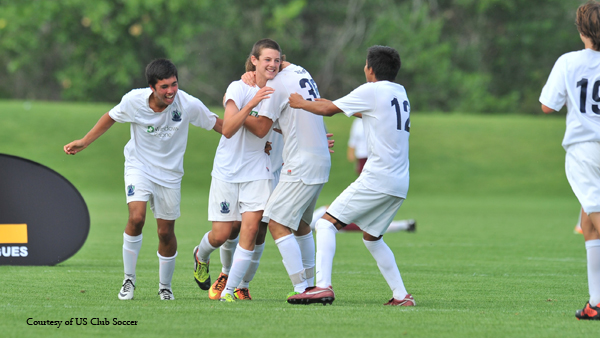SoccerWire Q&A, pt. 2: Kevin Payne on “the new buzzword” in youth soccer

Earlier this month US Club Soccer unveiled the “Players First” program, a new player development system “intended to transform the way youth soccer is viewed in the United States” by creating “a holistic club soccer experience for parents and players, emphasizing the development of each individual player to his/her full potential.”
+READ: US Club Soccer unveils new “Players First” youth development platform
US Club Soccer CEO Kevin Payne graciously shared plenty of useful perspective on this initiative as well as a host of other hot topics in U.S. youth soccer in an extended conversation with SoccerWire.com. This is the second part of our Q&A; find part 1 here.
SoccerWire: You previously mentioned the importance of coaching instruction, specifically in terms of taking best practices from leading countries around the world. Who should we be looking to?
Kevin Payne: The French were one of the first countries to really set out to create a national methodology for developing players – countries like Holland and Germany have had methodologies in the past, but the French completely revamped theirs in the early 1990s and took a really holistic view of it, and I think now everybody’s kind of copied that approach. I don’t mean that they’ve copied exactly what the French do, but they’ve copied the idea we need to have a national system that’s really comprehensive.
 The French have more players playing in the top five leagues in the world than any other country, so that gives them resources to choose from for the national team that we don’t have. And that’s all part of a process; it’s not going to happen overnight. But it also isn’t going to happen if we don’t try to expand our base of knowledge. That’s a big element of what we’re trying to do with Players First. That’s part of the resource provision that we’re trying to put into place.
The French have more players playing in the top five leagues in the world than any other country, so that gives them resources to choose from for the national team that we don’t have. And that’s all part of a process; it’s not going to happen overnight. But it also isn’t going to happen if we don’t try to expand our base of knowledge. That’s a big element of what we’re trying to do with Players First. That’s part of the resource provision that we’re trying to put into place.
SW: I have to ask you about the elephant in the room here – the United States’ “pay-to-play” system at the youth level.
KP: You know, that’s the new buzzword. In America, we’re always looking for the one thing – ‘If we just change this, everything’s going to be fine.’ That’s a big problem that we have. Pay-to-play is not going away. It’s silly to think it will. We will never have enough professional team academies in America to service the size of population. We’re essentially as big as Europe, and right now we have 20 MLS academies. We have 60 other academies plus or minus, that supporting, in many cases, their top developmental teams through a pay-to-play model. If we had 300 professional teams in America, all running academies, maybe the pay-to-play model in terms of elite player development would go away.
“Nobody is scientific enough to know who are the players, at the age of 8, 9, 10, 11, even 12, who are going to make it as professionals.”
But in the meantime, youth soccer is a vastly larger business enterprise than Major League Soccer. Just in terms of what families are paying to register their players and for additional coaching services – not counting travel, not counting everything else that goes along with the game – I think among the registered players in the United States Soccer Federation, there’s probably an expenditure somewhere between $4 and $5 billion – BILLION – a year. Some people think it’s a lot higher than that, and that’s a very broad extrapolation of what people are generally paying to register with clubs at different levels of competition. But I think that’s a fair number. That’s eight or 10 times the turnover of MLS. That’s more money than La Liga makes in a year. That’s probably as much as the EPL makes in a year.
+READ: Fullerton Rangers’ Jimmy Obleda calls out poaching: “Big academy clubs fish by net”
So it’s a huge business, so to suddenly say, ‘Oh, we’re going to do away with the pay-to-play model’ just isn’t recognizing the realities for what they are. Our objective is not to throw out the American youth soccer model and somehow convince people, ‘This is what you need to do,’ it’s to change the existing model for the better. The majority of young players in America are going to continue to pay to play, and I wager 100 percent of the future national team players that come up through our system in the United States, at some point in their development, they will pay to play.
 If U.S. Soccer thinks that it can somehow determine from, say, the age of 8, who the real prospects are and isolate them and cover their costs, then all that will accomplish is to eliminate probably 80 percent of the potentially available players for future development. Nobody is scientific enough to know who are the players, at the age of 8, 9, 10, 11, even 12, who are going to make it as professionals. And frankly, in our country, our attempts to that, to pick players probably too early in the process, might very well be the reason that we have tended to choose the players who are the most exceptional athletes at younger ages.
If U.S. Soccer thinks that it can somehow determine from, say, the age of 8, who the real prospects are and isolate them and cover their costs, then all that will accomplish is to eliminate probably 80 percent of the potentially available players for future development. Nobody is scientific enough to know who are the players, at the age of 8, 9, 10, 11, even 12, who are going to make it as professionals. And frankly, in our country, our attempts to that, to pick players probably too early in the process, might very well be the reason that we have tended to choose the players who are the most exceptional athletes at younger ages.
They are put in situations with their youth teams where their athleticism allows them to excel and they don’t ever learn how to play the game properly. Then they reach a point where now they’re playing in competition against kids from France or Germany or Argentina who are every bit as athletic as they are, but they can really play. And that’s when we start to recognize our shortcomings. So I think it’s naive to talk about eliminating pay-to-play. There’s a point at which highly-skilled players, players that truly are prospects for the highest levels, need to no longer be paying to play, because that becomes just another barrier, an artificial filter that has nothing to do with soccer skill. And you run the risk of eliminating those kids who can’t afford to pay to play. But to pretend that we’re just going to eliminate pay-to-play is very naive.
SW: That ties in to another pressing issue at the moment – U.S. Soccer’s long-standing refusal to employ the FIFA system of solidarity payments and training compensation for clubs that develop players who go on to professional careers and earn transfer fees. Where do you see that issue going?

KP: There are a lot of questions that need to be answered about that, including a lot of questions relating to U.S. law. People believe, when it comes to things like that, that FIFA’s regulations are binding across the globe, and that’s just absolutely not the case. All of FIFA’s regulations which include language like “except where prohibited by local law.” So FIFA tries to create a broad set of regulations to literally regularize the business of soccer, but they recognize that they can’t enact true legislation across 208 countries.
So I’m not sure what weight the FIFA regulations as it applies to solidarity and training compensation. I do think there are legal issues that have to explored in the United States, and we’re hoping to have a broader conversation on behalf of clubs with U.S. Soccer to look at the issue generally and say, ‘What would we like the outcome to be? What makes sense for everybody? Is there a common view of this?’ … There’s just too many unanswered questions about what we want to accomplish and what’s legal.
+READ: Solidarity – The missing piece in U.S. youth soccer’s development puzzle?
The question lies a little bit more with U.S. Soccer than with MLS. MLS stipulated in the court case Fraser vs. MLS that it would not collect, nor would it pay, compensation for out-of-contract players. That was a very broad categorization that, as much as anything else, had to do with senior players who were out of contract. That was triggered by the “Rozelle Rule” litigation in the United States, and [Europe’s] Bosman ruling … it wasn’t very specific about youth players. The federation signed a consent decree with the court, which we have not seen as yet, which addresses the issue more, and specifically as it relates to the FIFA regulations that exist in some other parts.
It’s the federation that collects and dispenses those monies. So it’s really, the federation is the key player in this, and that’s why we’re hoping to have a conversation with the federation to better understand their position, their interpretation of the law, what the consent decree might say, and what we all collectively think should be the right posture.











